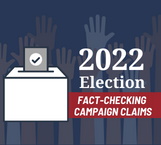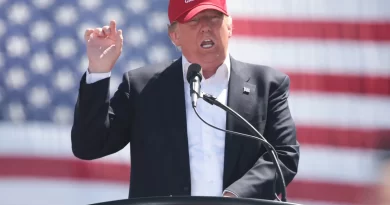Posts Misrepresent ‘Not Verified’ Code on Pennsylvania Ballot Applications
Quick Take
Pennsylvania uses a “not verified” code on mail-in ballot applications if a voter’s identity couldn’t be immediately verified; voters have six days after an election to submit a valid ID. But an Instagram post and some Republican leaders — including former President Donald Trump — falsely claim the state has “sent out 249,000 ballots to unverified voters” and misleadingly suggest it will result in widespread fraud.
Full Story
Pennsylvania’s election code requires that voters who aren’t able to provide a form of identification when they request an absentee or mail-in ballot still be able to receive and cast a ballot.
Those voters must submit a valid ID at least six days after the election, or the vote won’t be counted. There were about 7,600 applications requesting an absentee or mail-in ballot whose ID still needed to be verified as of Oct. 27, according to a press release from the Pennsylvania Department of State.
 The term “not verified” is a code used to mark application requests for a ballot in Pennsylvania if a voter’s identity couldn’t immediately be verified or if the identity needed to be verified again before the ballot can be approved. The term is not used to describe the result of an identity check.
The term “not verified” is a code used to mark application requests for a ballot in Pennsylvania if a voter’s identity couldn’t immediately be verified or if the identity needed to be verified again before the ballot can be approved. The term is not used to describe the result of an identity check.
But a claim being spread on social media and by several Republicans — including Pennsylvania State Rep. Francis Ryan and former President Donald Trump — misleadingly says that more than 240,000 ballots have been sent to unverified voters.
An Instagram post shared a screenshot of an Epoch Times headline saying, “Pennsylvania’s Department of State Has Sent Out 249,000 Ballots to Unverified Voters in 2022 Election.”
Ryan and 14 other state representatives sent a letter on Oct. 25 to Leigh Chapman, acting secretary of the commonwealth, asking for the Pennsylvania Department of State to immediately tell all counties to set aside the unverified ballots until the applicants provide a valid form of ID.
The misleading claim originated from a report published Oct. 24 by Verity Vote, which describes itself as an election integrity research and investigations group, and has been shared in social media posts and by several blogs. One comment on a post says, “It is not clear that Pennsylvania will reject the unverified ballots if they are [m]ailed in without proper ID. What a screw-up!”
The Verity Vote report said, “a shocking 249,000 unverified mail ballots have been sent to applicants who provided invalid identification or no identification at all” as of Oct. 17, and if proof of ID isn’t received, county election officials “can and do count the ballots without the ID from the voter.”
The report also said this could lead to “tens of thousands of unverified ballots” being accepted and claimed counties have already processed over 58,000 applications despite their failure to verify the voter’s identity.
But the claims misrepresent the “not verified” coding on the Pennsylvania ballot applications.
We reached out to Verity Vote for further evidence of its claims, but we didn’t hear back.
Pennsylvania’s Voting Process
In 2019, Pennsylvania’s Election Code, Act 77, was signed into law allowing the options for registered voters to vote by mail-in ballot, early in person at a county election office, and on Election Day at a polling location.
All 67 counties in Pennsylvania had updated voting systems as of June 2, 2020, “that produce voter-verifiable paper records and meet 21st-century standards of security, auditability and accessibility,” according to the Pennsylvania Department of State.
Registered voters applying for an absentee or mail-in ballot must supply a Pennsylvania driver’s license, the last four digits of their Social Security number or their Pennsylvania Department of Transportation photo ID number.
If the applicant doesn’t have one of these forms of ID, they must enclose a photocopy of an acceptable identification, such as a U.S. passport or a U.S. military ID. Registered voters can apply for a mail-in ballot and cast it the same day at their county board of elections office.
The Help America Vote Act of 2002, a federal voting law, requires that an applicant’s ID be verified with the Pennsylvania Department of Transportation or the commissioner of Social Security.
The applications are marked “not verified” or “NV” if a voter’s identity couldn’t immediately be verified or if the application needs to be verified again before the ballot can be approved, according to a statement sent to us by Amy Gulli, communications director for the Pennsylvania Department of State.
“For example, a ballot application would be marked with NV if it is a new application that comes in and the provided ID was not able to be immediately verified,” the press release said. “Or, for another example, a ballot application would be marked as NV if it is from a voter on the permanent mail-in or absentee list who requested a mail ballot for both the primary and general elections, and their ID needs to be verified again for the general election.”
In response to Ryan’s letter, Chapman, the acting secretary of the commonwealth, wrote, “Notably, the code does not reflect the results of any identification check but is, in fact, an additional mechanism to ensure that counties are properly verifying ID provided by voters.”
Applicants also have the ability to request to be placed on the annual mail-in voter list, allowing them to receive a mail-in ballot for every election. The request must be submitted every year. Chapman noted these applications may be marked “not verified” to ensure the voters go through verification every year.
Both the press release and Chapman’s letter noted there were about 7,600 applications that still needed ID verification. In her response to Ryan, Chapman said his letter “does not clearly delineate how you arrived at this number” of 249,000.
Act 77 requires that individuals who claim that they are registered voters but whose names don’t appear on the register, as well as individuals who are unable to provide proof of identification, be allowed to cast a provisional ballot.
But, as we said before, those voters will be required to submit a valid identification at least six days after the election or the vote won’t be counted. The press release from the Pennsylvania Department of State said the vast majority of voters provide proper identification during the application process.
In 2020, there were 21,117 rejected provisional ballots for the general election, according to data from the Pennsylvania Department of State. The department did not say why the ballots were rejected or how many of them were mail ballots. However, the U.S. Elections Project, which tracks early voting, reported that 7,411 mail ballots rejected in the 2020 general election in Pennsylvania were from “first time voters who did not provide required id with their mail ballot or a missing signature.”
Mail-in ballots are secured in three ways: An inner secret envelope that seals the ballot; the barcode on the outer envelope that is unique to each voter; and the secured chain of custody for the ballots. Voters must also sign and date the outer envelope or it won’t be counted, the Pennsylvania Department of State said.
Mail-in ballots must be received by county election officials before 8 p.m. on Election Day in order to be counted.
Before mail-in ballots are counted, they must be removed from the secure envelopes and prepped for scanning — which can’t begin until 7 a.m. on Election Day, according to Pennsylvania law.
Election results are expected to be available a few days after the election.
Editor’s note: FactCheck.org does not accept advertising. We rely on grants and individual donations from people like you. Please consider a donation. Credit card donations may be made through our “Donate” page. If you prefer to give by check, send to: FactCheck.org, Annenberg Public Policy Center, 202 S. 36th St., Philadelphia, PA 19104.
Sources
“3 REASONS YOUR MAIL BALLOT IS SECURE.” Pennsylvania Department of State. Accessed 3 Nov 2022.
“Act 77 – Pennsylvania Election Code.” legis.state.pa.us. 31 Oct 2019.
“Acting Secretary Of State Outlines Vote-Counting Process After Election Day In Pennsylvania.” Pennsylvania Department of State. 24 Oct 2022.
“Annual Mail Ballot List.” Pennsylvania Department of State. Accessed 3 Nov 2022.
Brelje, Beth. “Pennsylvania’s Department of State Has sent out 249,000 Ballots to Unverified Voters in the 2020 Election.” Epoch Times. Updated Oct 31.
Chapman, Leigh M. Acting Secretary of the Commonwealth of Pennsylvania. “Response to Rep. Ryan Letter.” 28 Oct 2022.
“Deadline To Apply For A Mail Ballot For The Midterm Election Is Nov. 1.” Pennsylvania Department of State. 25 Oct 2022.
“Election Security in Pennsylvania.” Pennsylvania Department of State. Accessed 3 Nov 2022.
“Frequently Asked Questions About Pennsylvania Elections.” Pennsylvania Department of State. Accessed 3 Nov 2022.
Gulli, Amy. Communications director, Pennsylvania Department of State. Email to FactCheck.org. 2 Nov 2022.
“Mail-in and Absentee Ballot.” Pennsylvania Department of State. Accessed 3 Nov 2022.
“Pennsylvania Application for Absentee Ballot.” Pennsylvania Department of State. Accessed 3 Nov 2022.
“Pennsylvania Application for Mail-in Ballot.” Pennsylvania Department of State. Accessed 3 Nov 2022.
Pennsylvania Department of State. “Acting Secretary of the Commonwealth Leigh M. Chapman.” Accessed 3 Nov 2022.
Pennsylvania Department of State. “Department of State Corrects Misinformation About ‘Unverified Ballots.’” Press release. 27 Oct 2022.
“Pennsylvania Voter-Not-Verified Vulnerability.” Verity Vote. 24 Oct 2022.


